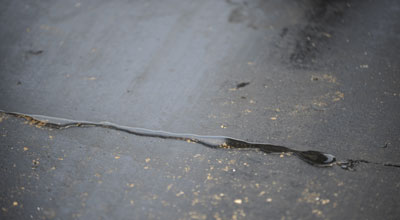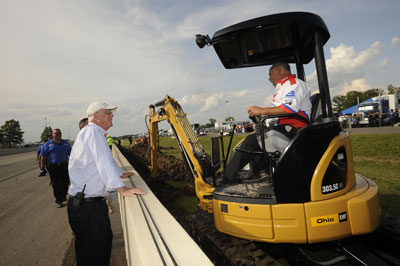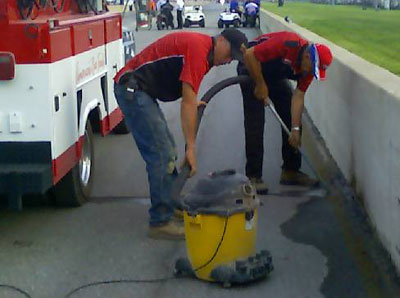

Norwalk, and The Big Dig
 |
|
|
|
|
|
|
We’ve all heard the fable of the little Dutch boy who used his finger to plug a leaking dike in Holland and remained there all night to save the land.
Well, the NHRA Safety Safari and Summit Motorsports Park team could have used an army of him and probably still lost the battle with Mother Nature that they waged for more than five hours late Friday afternoon.
Action was halted just before 4 p.m., early in the event’s first Pro Stock session, as rainwater, heated by a steamy day, percolated up through cracks and expansion joints in the asphalt shutdown area and puddled in numerous areas.
After a torrential week and a half of rain – 13 inches in the last 10 days according to track owner Bill Bader Sr. – the saturated soil beneath the track finally said “Enough” and up it came in more than dozen spots.
NHRA and Norwalk workers initially mopped, dried, vacuumed, blew, and toiled over the water, but every time that they cleared a crack, the water quickly seeped topside.
It was like a nightmarish game of Whack-A-Mole as water kept reappearing or popping up in other places every time backs were turned.
To make matters worse, a huge rainstorm was bearing down on the facility that only promised to add to our woes.
The great thing about the people in the sport is their vast expertise. Jim Head, an engineer by trade, weighed in with his opinion on how to improve the drainage. After a Caterpillar unit on display on the Manufacturers Midway was brought to the scene, Top Alcohol Funny Car champ Frank Manzo, who runs a construction business, hopped aboard and commenced the digging before being replaced later by a local Cat dealer. A large trench a couple of hundred feet long – and several perpendicular to the track -- was dug alongside the right guardwall to give the water somewhere to run to from under the track. Grooves also were recut horizontally in the track to aid the blowing of water to the trench.
Every manner of sweeping and track drying, flame-throwing equipment was put into action to repeatedly go over the areas, and when the anticipated storm fizzled and drifted south, things looked promising.
So typical of his nature, Bader himself was not only supervising but was hands on as well, helping vacuum water out of holes drilled through the surface.
“In my entire history I’ve never seen the volume of water come up through the racetrack that I have seen today,” he said later. Bader has owned the track since 1974.
Just as it looked like the situation was under control and NHRA Senior Vice President-Racing Operations Graham Light had issued a 10-minute alert, water also was coming up at places on the actual quarter-mile, which also were quickly attended to, but, again, at this point it seemed like a losing battle was being waged.
As night set in and no complete resolution was in sight, NHRA officials made the decision at about 9:15 that, in consideration for the safety of the competitors, racing was done for the day.
A heartsick Bader got onto the PA and made and long and passionate apology to the fans who have helped the track grow over the years and guaranteed fans a complete voucher for the day and then turned loose an impressive fireworks display as a final "thank you" to the fans who sat patiently for hours waiting for the action to resume.
Tomorrow's going to be a busy day as we play catch up, but it won't be from the lack of effort after an heroic day of trying to plug the unpluggable.






















































